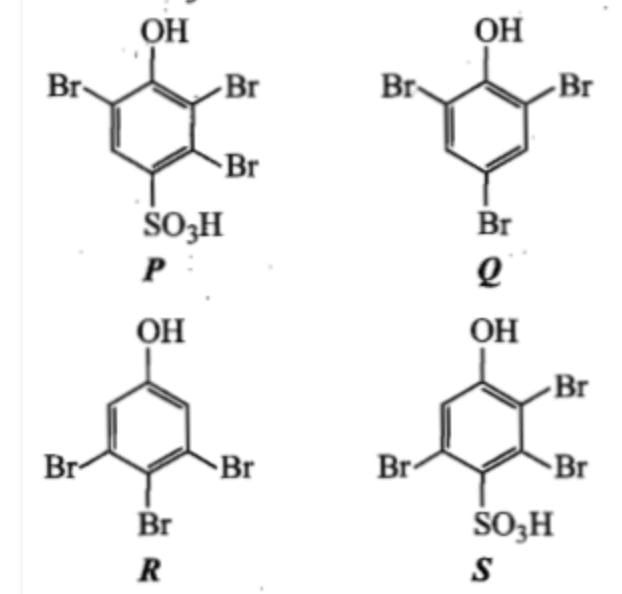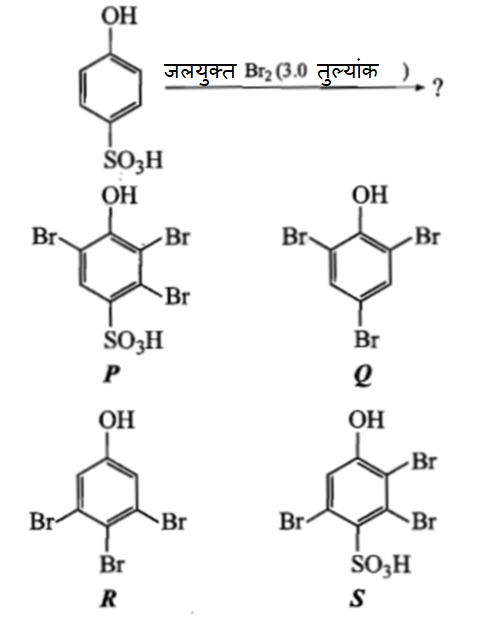
Compound (C) in above reaction is:
(1) -hydroxy acid
(2) -amino acid
(3) -amino alkanol
(4) -amino -hydroxy acid

उपरोक्त अभिक्रिया में यौगिक (C) है:
1. -हाइड्रॉक्सी अम्ल
2. -एमीनो अम्ल
3. -एमीनो एल्केनोल
4. -एमीनो -हाइड्रॉक्सी अम्ल


Main product of the reaction,
CH3CONH2+HNO2 ... is:
(1) CH3COOH
(2) CH3CH2NH2
(3) CH3NH2
(4) CH3COONH4
अभिक्रिया CH3CONH2+HNO2 ..., का मुख्य उत्पाद है:
1. CH3COOH
2. CH3CH2NH2
3. CH3NH2
4. CH3COONH4
W is
| (1) | CH2 = CH − CH = CH2 |
| (2) | CH3 − CH = CH − CH = CH2 |
| (3) |  |
| (4) | CH3 − CH = CH − CH = CH − CH3 |
W है-
| (1) | CH2 = CH − CH = CH2 |
| (2) | CH3 − CH = CH − CH = CH2 |
| (3) |  |
| (4) | CH3 − CH = CH − CH = CH − CH3 |
The major products(s) of following reaction is (are):


(1) P
(2) Q
(3) R
(4) S
निम्नलिखित अभिक्रिया के मुख्य उत्पाद है (हैं):

1. P
2. Q
3. R
4. S
a-chloropropionic acid on treatement with alcoholic KOH followed by acidification gives:
1.
2.
3.
4. None of these
a-क्लोरोप्रोपेनोइक अम्ल एल्कोहॉलिक KOH के साथ उपचार के बाद अम्लीयकरण द्वारा देता है:
An ester is boiled with KOH. The product is cooled and acidified with conc. HCl. A white crystalline acid separates. The ester is
1. methyl acetate
2. ethyl acetate
3. ethyl formate
4. ethyl benzoate
एक एस्टर को KOH के साथ उबाला जाता है। उत्पाद को सांद्र HCl के साथ ठंडा और अम्लीकृत किया जाता है। एक सफेद क्रिस्टलीय अम्ल पृथक हो जाता है। एस्टर है:
1. मेथिल एसीटेट
2. एथिल एसीटेट
3. एथिल फॉर्मेट
4. एथिल बेंजोएट
When is reduced by LiAlH4, the compound obtained is :
(1) CH3CH2COOH
(2) CH2=CHCH2OH
(3) CH3CH2CH2OH
(4) CH3CH2CHO
जब को LiAlH4 द्वारा अपचयित किया जाता है, प्राप्त यौगिक है:
1. CH3CH2COOH
2. CH2=CHCH2OH
3. CH3CH2CH2OH
4. CH3CH2CHO
Wacker method is used to convert alkene into corresponding ......... using PdCl2.
(1) alcohol
(2) ketone
(3) aldehyde
(4) acid
वाकर विधि का उपयोग PdCl2 का उपयोग करके एल्कीन को संबंधित ........ में परिवर्तित के लिए किया जाता है।
1. एल्कोहॉल
2. कीटोन
3. एल्डिहाइड
4. अम्ल
In Etard's reaction, toluene is oxidised to benzaldehyde using:
1. H2O2
2. Cl2
3. chromium trioxide or CrO2Cl2
4. KMnO4
ईटार्ड अभिक्रिया में, टॉलूईन किसका उपयोग कर बेन्ज़ैल्डिहाइड में ऑक्सीकृत हो जाता है:
1. H2O2
2. Cl2
3. क्रोमियम ट्राइऑक्साइड या CrO2Cl2
4. KMnO4
Consider the following compounds :
The Correct decreasing order of their reactivity towards hydrolysis is :
1. (ii) > (iv) > (iii) > (i)
2. (i) > (ii) > (iii) > (iv)
3. (iv) > (ii) > (i) > (iii)
4. (ii) > (iv) > (i) > (iii)
निम्नलिखित यौगिकों पर विचार कीजिए:
जल-अपघटन के प्रति उनकी अभिक्रियाशीलता का सही घटता क्रम है:
1. (ii) > (iv) > (iii) > (i)
2. (i) > (ii) > (iii) > (iv)
3. (iv) > (ii) > (i) > (iii)
4. (ii) > (iv) > (i) > (iii)







